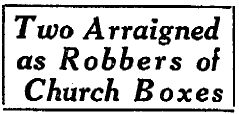Author: Mary McCoy
Can You Do the Kinkajou?

After attending the 1927 annual convention of the Dance Masters of America, Ryan told the Los Angeles Times that he expected a Kinkajou craze to overtake California by winter, and that he would be teaching the steps in his studio at 1500 S. Figueroa.
The Kinkajou was created by Edna Passpae, inspired by a song and dance number from the 1927 Ziegfield musical Rio Rita that included the lyrics, "When you do the Kinkajou, you dance before you think." She debuted it at the DMA convention where it won first prize, beating out new steps like the Dixie Stomp and the Lindbergh Glide.
It was said that the Kinkajou would "be the dance to replace the Charleston and the Black Bottom." Sadly, the Kinkajou’s moment in the sun was brief. Rio Rita, however, went on to become an early talkie hit for RKO, starring Bebe Daniels and John Boles, and marking the film debut of comedy team Wheeler and Woolsey.
Winnie, Minnie, and Baby Norman
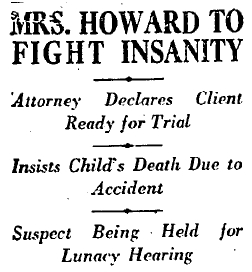 Last week, we learned of a baby found dead in a Main Street flophouse, apparently strangled, with cotton stuffed in his nose and mouth. Police were looking for the woman who’d registered for the hotel room, a Mrs. W. Howard, who’d left the establishment the day before the infant’s body was discovered. Since then, things have gone from curious to curiouser.
Last week, we learned of a baby found dead in a Main Street flophouse, apparently strangled, with cotton stuffed in his nose and mouth. Police were looking for the woman who’d registered for the hotel room, a Mrs. W. Howard, who’d left the establishment the day before the infant’s body was discovered. Since then, things have gone from curious to curiouser.
Police found a bundle of little Norman Howard’s sleepers stashed in a downtown department store shortly after the body was found. Captain of Detectives Bean said, "The mother is probably wandering around in a deranged condition and I believe she will either attempt to take her life or will put in an appearance at some institution within a few hours."
While they continued to search for Howard, police investigations uncovered some information about the missing mother and her recent activities. Winnie Howard, 35, and her husband, Frank, had purchased a chicken farm in Norco, but separated soon afterwards; Winnie left the farm when she could no longer make the payments. Since then, she’d been staying with her baby in hotels around Riverside and Corona, finally going to her twin sister Minnie’s home in Reseda.
After days of searching, Winnie Howard was finally found on the evening of August 26, not in the ocean, but at a Sierra Madre campground. She’d registered there under a false name, but had never claimed her campsite. Instead, Winnie had spent the four days since the death of her son wandering the hills without food or water. She was taken into custody, and placed under psychiatric watch. Upon hearing of Howard’s plight, a group of philanthropic club women took pity on her, and retained Attorney Milton Golden to defend her.
Today, homicide investigator Eddie King files an insanity complaint against Howard, and the District Attorney’s Office warned that if Howard was found sane, they would charge her with murder. Golden replied that, despite this, they would fight the insanity charge. He said, "Mrs. Howard is not insane. She accidentally rolled over on the child in her sleep and caused its death. If the District Attorney’s office wants to file a murder complaint, we are ready to go to trial."
As far as the Los Angeles Times shows, it never came to that. On September 6, Howard was declared sane and sent to a sanatorium for two weeks to complete her recovery. Afterwards, she was released into Minnie’s custody.
Born Out of Tragedy
Van Nuys
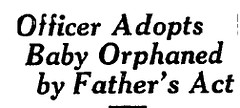 One August night in 1927, Edgar Burnett of Van Nuys shot his wife, then turned the gun on himself, leaving their four children orphaned. The children were separated, and taken in by different families. Eleanor Ray Burnett, 7, was adopted by a wealthy Anaheim family; Ermie Jean, 3, was sent to Toronto to live with Miss Myrtle Hendrie; and Edgar Jr., 16 months, went to a Van Nuys family.
One August night in 1927, Edgar Burnett of Van Nuys shot his wife, then turned the gun on himself, leaving their four children orphaned. The children were separated, and taken in by different families. Eleanor Ray Burnett, 7, was adopted by a wealthy Anaheim family; Ermie Jean, 3, was sent to Toronto to live with Miss Myrtle Hendrie; and Edgar Jr., 16 months, went to a Van Nuys family.
And today, the Burnett’s newborn daughter, Nona Lee, was adopted by Patrolman James Hayden of the Van Nuys police station and his wife. Nona was only 5 days old at the time of the killings, and the babe had been in her mother’s arms when Edgar Burnett fired the fatal shots. In 1927, it was reported that the Hayden’s would rear Nona "never to know the tragedy of her early life," or about her brother and sisters.
However, at some point, the Hayden’s must have decided to tell Nona the truth about her past. And it seems a good thing they did.
You see, on Halloween night, 24 years later, 24-year-old Louis Shandra wrote a note, and went to his estranged wife’s apartment. The note read, "I am going to kill my wife and myself tonight. I love her more than anything else in the world."
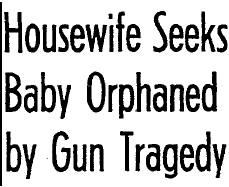 Shandra had recently served 30 days for beating his wife, Carmela, who had moved into her own place while Shandra was in jail. He went to the apartment at 808 E. Palmer Ave., Glendale, and shot Carmela to death with a rifle in front of the couple’s 2-year-old son, Bobby. Then, Shandra went into another apartment in the building, and killed himself.
Shandra had recently served 30 days for beating his wife, Carmela, who had moved into her own place while Shandra was in jail. He went to the apartment at 808 E. Palmer Ave., Glendale, and shot Carmela to death with a rifle in front of the couple’s 2-year-old son, Bobby. Then, Shandra went into another apartment in the building, and killed himself.
A Ventura housewife married to Deputy Sheriff Warren Paul read about the tragedy in Glendale, and was so moved that she and her husband offered to adopt the child themselves. Nona Hayden Paul told the Los Angeles Times the circumstances of her early childhood and said, "I wondered what would happen to that poor little boy. I talked to my husband about it and we’ve decided we’d love to raise him on our own." Warren Paul agreed readily – he, too, had been adopted as a child.
Don’t Get Mad, Get Everything
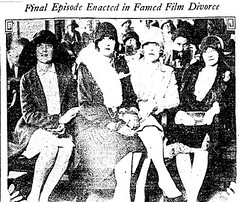 Hollywood divorces may be ugly today, but the dissolution of the legal bonds between Charlie Chaplin and his child bride, Lita Grey, may have been nastier than K-Fed and Britney, Alec and Kim, and Loni and Burt put together.
Hollywood divorces may be ugly today, but the dissolution of the legal bonds between Charlie Chaplin and his child bride, Lita Grey, may have been nastier than K-Fed and Britney, Alec and Kim, and Loni and Burt put together.
After divorce proceedings that had dragged on for nearly a year, Chaplin and Grey settled out of court today for the staggering sum of nearly $1 million ($11,971,200 USD 2007). $625,000 went to Lita, $200,000 was used to set up trust funds for the couple’s two babies, and the rest went towards assorted legal and court fees. She lost the house, but got custody of the children. It was, in 1927, the largest divorce settlement ever paid in California history.
Lita was only 18, but she was either exceptionally shrewd or exceptionally wronged.
Wed in Mexico in November 1924, Lita moved out almost exactly two years later. However, the marriage was in trouble quite literally from the beginning.
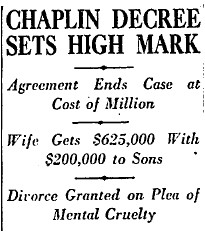 In her nearly 50-page formal complaint against Chaplin, Grey leveled the following accusations: he’d forced her to have sex with him before they were married; he’d told her to get an abortion when he discovered she was pregnant; on their way back to Los Angeles after their wedding, he told her, “This marriage won’t last long. I’ll make you so — sick of me that you won’t want to live with me”; accused her of forcing him into marriage; had an affair with a prominent motion picture actress; told her she was stupid; encouraged her to commit suicide; only took her out 3-4 times during the first two months of their marriage “for the sake of appearances”; left her alone on Christmas while he went out and got drunk; threatened her life twice with a loaded revolver; and since their separation, had only given her $27 for milk for the babies.
In her nearly 50-page formal complaint against Chaplin, Grey leveled the following accusations: he’d forced her to have sex with him before they were married; he’d told her to get an abortion when he discovered she was pregnant; on their way back to Los Angeles after their wedding, he told her, “This marriage won’t last long. I’ll make you so — sick of me that you won’t want to live with me”; accused her of forcing him into marriage; had an affair with a prominent motion picture actress; told her she was stupid; encouraged her to commit suicide; only took her out 3-4 times during the first two months of their marriage “for the sake of appearances”; left her alone on Christmas while he went out and got drunk; threatened her life twice with a loaded revolver; and since their separation, had only given her $27 for milk for the babies.
Apparently, Chaplin decided the money was worth his peace of mind – he didn’t even show up in court. Earlier in the year, Chaplin had filed a cross-complaint that denied many of Grey’s charges, and accused her of excessive partying, relationships with other men, and negligent parenting; however, this complaint was dismissed at the time of the settlement.
The Celebrated Portia
Los Angeles
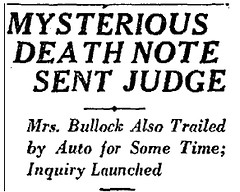 When you’re the first female jurist to serve in the state of California, celebrity finds you, whether you want it or not. Today, police began investigating a series of death threats sent to Municipal Judge Georgia Bullock. The letters had been arriving steadily for six weeks, but Bullock hadn’t taken them seriously until last week, when she realized she was being followed by a lone figure in a large car.
When you’re the first female jurist to serve in the state of California, celebrity finds you, whether you want it or not. Today, police began investigating a series of death threats sent to Municipal Judge Georgia Bullock. The letters had been arriving steadily for six weeks, but Bullock hadn’t taken them seriously until last week, when she realized she was being followed by a lone figure in a large car.
The most recent missive read, "Leave state at once. Your life will go and you will get this." Beneath these lines was scrawled a crude drawing of a revolver. The note was signed "Black Hand Boston – You Cannot Escape."
Bullock had received similar threats two years earlier, when she received her first appointment as a police judge in December 1924. Shortly after assuming her post, she was the victim of a half-hearted poisoning attempt, when a "woman of foreign appearance" left a box of strangely-colored fudge in her quarters.
 Happily, the villains never succeeded in carrying out their threats, and Bullock went on to serve as a judge in Los Angeles for 32 years until her retirement in 1955. She specialized in hearing cases involving marriage, divorce, and homeless children, but her happiest years came at the end of her career, which she spent in the Adoption Department of the Juvenile Court. Upon her retirement, she said, "I’m going to miss it. I’ll miss seeing the little ones that have been such darlings in my courtroom these last twelve years, and I’ll miss watching that wonderful happiness that childless couples show when they are adopting children."
Happily, the villains never succeeded in carrying out their threats, and Bullock went on to serve as a judge in Los Angeles for 32 years until her retirement in 1955. She specialized in hearing cases involving marriage, divorce, and homeless children, but her happiest years came at the end of her career, which she spent in the Adoption Department of the Juvenile Court. Upon her retirement, she said, "I’m going to miss it. I’ll miss seeing the little ones that have been such darlings in my courtroom these last twelve years, and I’ll miss watching that wonderful happiness that childless couples show when they are adopting children."
Bullock died April 29, 1957, leaving two children, five grandchildren, and two great-grandchildren.
Ghastly

You see, at the tender age of 14, Paul Daedler was accused of one of the grisliest crimes in Pasadena history. Paul came from a good family, but it was reported that he attended the Monroe School for Subnormal Children along with his friend, William "Billie" Forrester. William was adopted, and had been in trouble with the law since he was 12, when he stole $500 from a neighbor and ran off to Arizona.
After school on December 5, 1923, Paul and William were playing with 5-year-old Arthur Martinez, the youngest child of a Pasadena gardener, in an abandoned factory at 950 S. Raymond Ave. They had a loaded .22 with them. Exactly what happened in the factory is uncertain, but little Arthur was shot twice in the head and once in the back. The shots didn’t kill him, though. Scared that Arthur would squeal on them, Paul and William beat him over the head with a brick, tied him to a pole with wire, and left him overnight. When they came back to the factory the next day, (to free him, they said), the boy was dead.
Paul and William went to the police and reported that they "found" Arthur in the factory. However, the police were suspicious of the boys, and after questioning, both confessed. At the inquest, the two expressed little emotion or remorse for what they had done, though the truant officer sitting near them in the courtroom had them shaking in their boots.
On December 20 hearing, Paul was joined by two lawyers, his parents, sisters, and a bevy of witnesses, while William had only his mother by his side. Although Paul had signed two confessions of guilt, his lawyers called witnesses to establish Paul’s alibi for the time of the killing. Paul also stated that he’d attended school on December 5, then rode his bicycle to a confirmation class at his church. The pastor of Paul’s church testified that Paul had been in class, although his schoolteacher, Miss Anna Crane, said that she had not seen Paul after 2pm on the day of the murder.
William was sent to the Preston State School on his 15th birthday to await trial, while Paul was sent to the Whittier State School. Their names and school ID numbers are included in the California Youth Authority Name Index for 1924 . However, a month after being sentenced to Ione, William produced a confession that absolved Paul of all blame in the killing. In his confession, William said, "I pulled the gun and shot him. Then I though I would put the blame on someone else, so I shot him two more times. I happened to think that whenever Paul Daedler got mad, he always threw bricks, so I decided to throw bricks at Arthur so it would appear that Paul hit him."
Later, it was revealed that a person interested in the case of Paul Daedler had visited him at the Preston School earlier and persuaded him to change his confession. The possibility that Paul’s family pressured the poor and unconnected William to take the rap for his friend is not unthinkable. As the boys sat in juvenile facilities, the Daedler family and their lawyers sought a writ of habeas corpus on behalf of Paul, saying that he had been confined to Whittier without a trial before a jury.
The judge upheld Paul’s detention.
Finally, after serving 17 months at Whittier, Paul was released into the custody of a judge, who ruled that the boy must leave the state, never to return. Paul’s father, Louis Daedler took him east so he could begin a new life. However, less than two years later, Paul was in County Jail on a vagrancy charge, having hitchhiked his way back to California. And today, he was returned to the juvenile facility. If the case did come to trial at some point, it was not reported in the Times.
Paul Daedler died in Los Angeles on December 21, 1981. William Forrester was paroled from the Preston School on November 19, 1925, and disappeared without a trace.
A Beautiful Friendship

Mathis had "discovered" Valentino, literally plucking him from a chorus of extras to star in her Four Horsemen of the Apocalypse in 1921. The two adored one another, though their friendship suffered a rocky period after Valentino was critical of one of her treatments. However, the good friends were reconciled at the Los Angeles premiere of The Son of the Shiek, shortly before Valentino’s death in August 1926.
As Valentino’s body was interred, Mathis supposedly said, "Rudy, you can stay there until they place me in it."
Sadly, this turned out to be a little sooner than anyone had expected. While attending a play in New York City on July 26, 1927, Mathis suffered a fatal heart attack. Her body was transported by train to Los Angeles, just as Valentino’s had been less than a year before.
“Death Dinner” — the Dinner That Killed!

Initially, the cause of death was ruled as heart disease, but Carson’s widow insisted that he’d been in excellent health before sampling her cooking. The circumstances were indeed strange, and Mrs. Carson was insistent enough that an autopsy was performed.
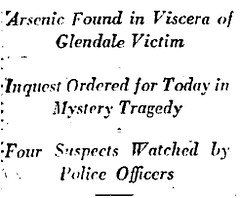 Today, Dr. A.F. Wagner, county autopsy surgeon announced that a quantity of arsenic had been found in Carson’s viscera. An inquest was ordered, with Mrs. Carson and J.E. Walker, Carson’s business partner appearing as key witnesses. And of course, the Times gave the whole thing a clever name, just in case the story had legs.
Today, Dr. A.F. Wagner, county autopsy surgeon announced that a quantity of arsenic had been found in Carson’s viscera. An inquest was ordered, with Mrs. Carson and J.E. Walker, Carson’s business partner appearing as key witnesses. And of course, the Times gave the whole thing a clever name, just in case the story had legs.
At the inquest on July 26, Mrs. Carson testified that J.E. Walker, her husband’s business partner, had given her a box of candy and a bunch of bananas, which she’d feared to be poisoned. Walker was outraged at the suggestion, saying that since he stood to make 50% off of the oil pump Carson had been developing, it was certainly in his best interests for Carson to remain alive. Then, a bit cruelly, he added that he’d given Mrs. Carson a reducing recipe along with the candy because he thought she was "too fat." Then again, the woman had all but called him a murderer, so I guess he was entitled to a little snippiness.
Oddly, Carson said that she’d wrapped up the candy and bananas, given them back to Walker, and told him to burn the parcel in his incinerator without telling him what it contained. When asked why she’d done this, Carson said that she hadn’t wanted the parcel littering up her kitchen.
Though there was certainly something fishy about this case, investigators were unable to piece together enough evidence to prove a murder had taken place, and the inquest was closed on July 29, 1927, less than a week after it was opened. In fact, just about the only thing that was established was that Carson had most likely NOT committed suicide or consumed the arsenic accidentally by drinking from an irrigation ditch near an oil well. Just how 40 grains of arsenic got into his belly remains a mystery.
Their Mothers Must Be Proud
